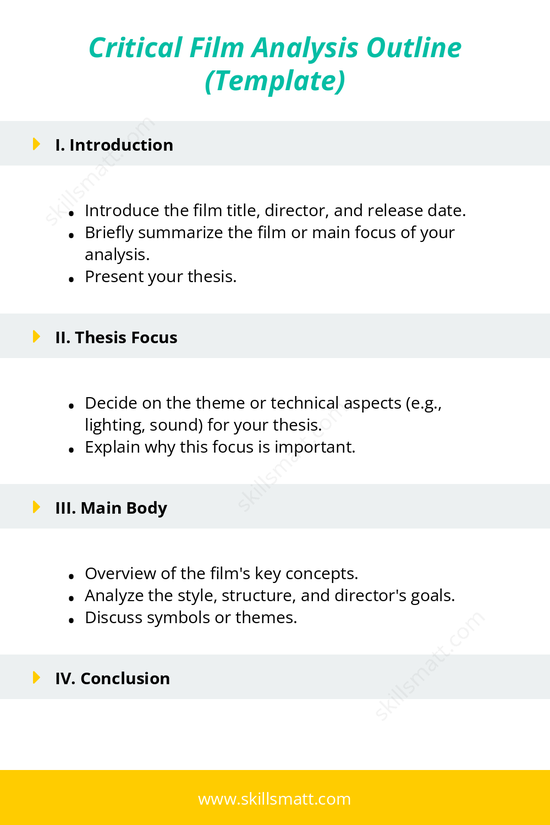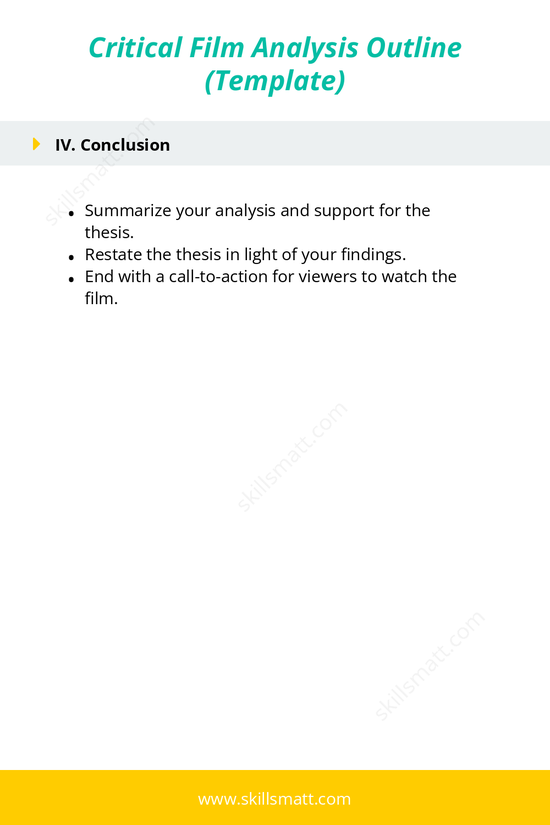Critical Film Analysis Outline (Template)
I. Introduction
- Introduce the film title, director, and release date: Provide the essential details about the film you are analyzing. Include the full title, the name of the director, and the year of release to give context.
- Briefly summarize the film or main focus of your analysis: Provide an overview of the film’s plot or the main element you intend to analyze. This could be a central theme, specific character, or even the director’s cinematic style.
- Present your thesis: Outline the purpose of your analysis and state your main argument or focus. What aspect of the film will you explore in-depth? Your thesis should guide your entire analysis.
II. Thesis Focus
- Decide on the theme or technical aspects (e.g., lighting, sound) for your thesis: Choose a central theme or technical feature that your analysis will focus on. This could be an overarching theme like 'identity,' a recurring symbol, or technical elements like cinematography, sound design, or editing techniques.
- Explain why this focus is important: Justify why this element is significant in understanding the film’s meaning or impact. How does this theme or technique influence the audience’s interpretation of the film? Provide examples from the film to support your point.
III. Main Body
- Overview of the film’s key concepts: Provide a concise summary of the key ideas or concepts explored in the film. This could include the main conflict, the protagonist’s journey, or the socio-political context the film addresses.
- Analyze the style, structure, and director’s goals: Evaluate how the film is constructed and what the director aimed to achieve. Consider aspects such as pacing, shot composition, narrative structure (linear vs. non-linear), and the visual style of the film. How do these choices serve the film’s themes?
- Discuss symbols or themes: Explore the recurring symbols or major themes and their significance in the film. Look for visual motifs, symbolic objects, or thematic elements that contribute to the film’s message. Analyze how these elements relate to the central thesis.
- Evaluate performances and character development: Examine the performances of key actors and how they contribute to the story. Discuss the development of main characters and how their arc contributes to the themes and emotional depth of the film.
- Assess the film’s cultural or historical context: Discuss any relevant social, political, or cultural context that influences the interpretation of the film. How does the film reflect, critique, or engage with its cultural or historical moment?
IV. Conclusion
- Summarize your analysis and support for the thesis: Recap the main points of your analysis and reinforce your thesis statement. Restate how your findings support the argument you made in your introduction.
- Restate the thesis in light of your findings: Reaffirm your thesis based on the evidence provided in the main body. How does the evidence you've presented validate your original perspective on the film?
- End with a call-to-action for viewers to watch the film: Conclude by encouraging readers to view the film based on your analysis. Highlight why it’s worth watching, or suggest what viewers should look for when they watch the film.
- Offer potential further areas of analysis: Suggest other aspects of the film or related works that could be explored further. This could include alternative interpretations, comparisons with other films, or deeper dives into underexplored elements of the film.


